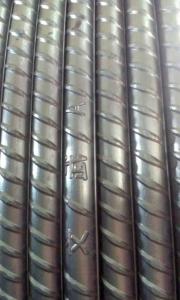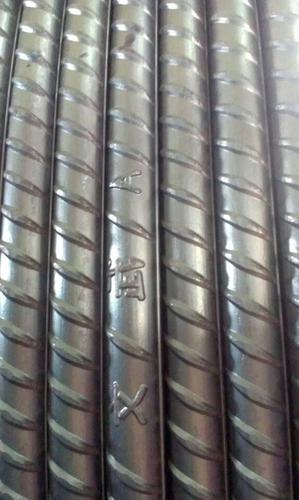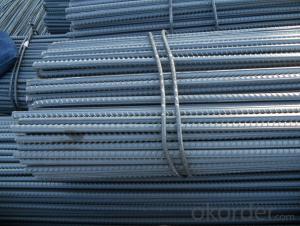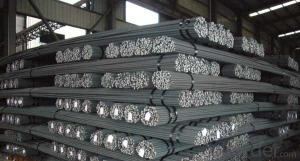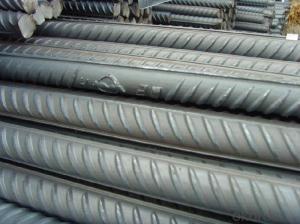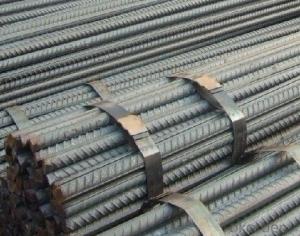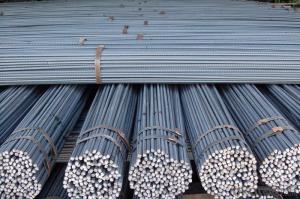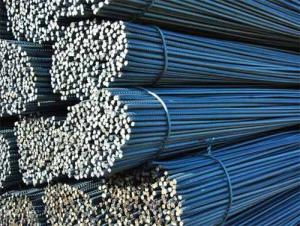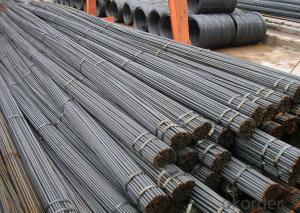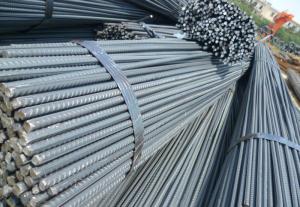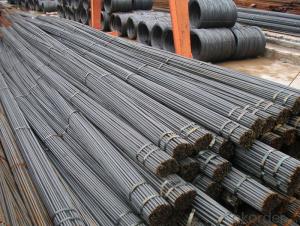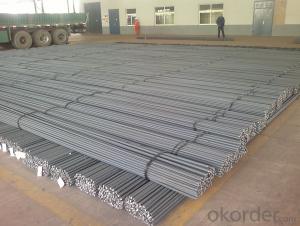Cold Rolled Steel Rebar 14mm
- Loading Port:
- China Main Port
- Payment Terms:
- TT OR LC
- Min Order Qty:
- -
- Supply Capability:
- -
OKorder Service Pledge
OKorder Financial Service
You Might Also Like
Theoretical weight and section area of each diameter as below for your information:
Diameter(mm) | Section area (mm²) | Mass(kg/m) | Weight of 12m (kg) | Pcs/ton |
6 | 28.27 | 0.222 | 2.664 | 375.38 |
8 | 50.27 | 0.395 | 4.74 | 210.97 |
10 | 78.54 | 0.617 | 7.404 | 135.06 |
12 | 113.1 | 0.888 | 10.656 | 93.84 |
14 | 153.9 | 1.21 | 14.52 | 68.87 |
16 | 201.1 | 1.58 | 18.96 | 52.74 |
18 | 254.5 | 2.00 | 24 | 41.67 |
20 | 314.2 | 2.47 | 29.64 | 33.74 |
22 | 380.1 | 2.98 | 35.76 | 27.96 |
25 | 490.9 | 3.85 | 46.2 | 21.65 |
28 | 615.8 | 4.83 | 57.96 | 17.25 |
32 | 804.2 | 6.31 | 75.72 | 13.21 |
36 | 1018 | 7.99 | 98.88 | 10.43 |
40 | 1257 | 9.87 | 118.44 | 8.44 |
50 | 1964 | 15.42 | 185.04 | 5.40 |
Cold Rolled Techniques
Yield Point: 545-565mpa
Deformed bar is widely used in buildings, bridges, roads and other engineering construction. Big to highways, railways, bridges, culverts, tunnels, public facilities such as flood control, dam, small to housing construction, beam, column, wall and the foundation of the plate, deformed bar is an integral structure material. With the development of world economy and the vigorous development of infrastructure construction, real estate, the demand for deformed bar will be larger and larger.
- Q: How are steel rebars spliced or connected in construction joints?
- Various methods are used to splice or connect steel rebars in construction joints, ensuring the integrity and strength of reinforced concrete. A common method is lap splicing, where rebars are overlapped and then mechanically connected or tied together with steel wires or couplers. The required overlap length for lap splicing depends on the rebar diameter and design specifications, often specified as a multiple of the diameter. This length guarantees efficient load transfer and prevents potential failures at the connection point. Mechanical couplers offer an alternative method for splicing rebars. These pre-fabricated devices securely connect two rebars, eliminating the need for lap splicing and providing a more precise and reliable connection. Mechanical couplers are particularly useful when dealing with larger rebar sizes or when long lap lengths are not feasible. In certain cases, welded splicing may be used. This method involves welding the ends of rebars together, creating a solid and continuous connection. Welded splicing is commonly employed when dealing with larger diameter rebars and higher load requirements. However, it is crucial to adhere to proper welding techniques and practices to maintain the connection's integrity. Overall, the splicing or connection of steel rebars in construction joints is a crucial aspect of reinforced concrete construction. It ensures that rebars function as continuous reinforcement, enabling structures to effectively resist applied loads. The choice of splicing method depends on factors such as rebar size, design specifications, and project requirements.
- Q: Can steel rebars be used in architectural or decorative concrete applications?
- Yes, steel rebars can be used in architectural or decorative concrete applications. They provide structural reinforcement and enhance the overall strength and durability of the concrete. Additionally, when properly designed and installed, steel rebars can be concealed or incorporated into the design, making them suitable for various aesthetic purposes in architectural or decorative concrete projects.
- Q: Can steel rebars be used in railway and transportation infrastructure?
- Yes, steel rebars can be used in railway and transportation infrastructure. Steel rebars, also known as reinforcing bars, are commonly used in the construction industry to provide strength and support to concrete structures. In railway and transportation infrastructure, where robust and durable structures are required, steel rebars are often used to reinforce concrete elements such as bridge piers, abutments, and retaining walls. The use of steel rebars in railway and transportation infrastructure offers several advantages. Firstly, steel rebars enhance the tensile strength of concrete, making the structures more resistant to the dynamic and heavy loads imposed by trains and vehicles. This is particularly important in bridges and elevated structures where the loads can be significant. Secondly, steel rebars provide structural integrity and prevent the development of cracks and deformations in the concrete. This is crucial for maintaining the long-term stability and safety of the infrastructure, especially considering the constant exposure to various environmental conditions, such as temperature variations and vibrations. Furthermore, steel rebars are highly durable and resistant to corrosion, which is essential in railway and transportation infrastructure that is often exposed to harsh weather conditions and chemical agents. Their ability to withstand these factors ensures the longevity of the structures and reduces the need for frequent repairs and maintenance. In conclusion, steel rebars can and are commonly used in railway and transportation infrastructure due to their ability to enhance the strength, durability, and stability of concrete structures. Their use ensures the safe and reliable operation of these vital transportation systems, providing a solid foundation for the efficient movement of people and goods.
- Q: Why is the earthing device forbidden to use thread steel instead of round steel as lap steel bar?
- The mechanical strength of the steel thread is destroyed. Because the supporting point is only the ground, it is easy to cut the steel directly if the thread is not vertical. Therefore, we need to use angle iron, steel pipe or smooth steel round bar.
- Q: Can steel rebars be used in high-strength concrete?
- Indeed, steel rebars have the capability of being utilized in high-strength concrete. In reality, steel rebars are commonly employed to reinforce concrete structures, regardless of the concrete's strength. High-strength concrete pertains to a type of concrete that possesses a significantly higher compressive strength when compared to conventional concrete. Its compressive strength typically exceeds 6,000 psi (pounds per square inch). The presence of steel rebars in high-strength concrete is essential as they provide the necessary tensile strength. Although concrete exhibits commendable compressive strength, its tensile strength is relatively feeble. By incorporating steel rebars into the concrete, the composite material becomes more robust and durable. The rebars act as reinforcement, effectively resisting the tensile forces and averting cracks or structural failure. Nevertheless, it is crucial to emphasize the importance of selecting the appropriate steel rebar for high-strength concrete. The rebars employed must possess adequate strength and ductility to endure the elevated stresses and strains associated with high-strength concrete. Moreover, proper placement, spacing, and anchorage of the rebars are vital to ensure effective reinforcement and optimal performance of the concrete structure. In summary, it is undeniable that steel rebars can certainly be utilized in high-strength concrete to augment its tensile strength and overall structural integrity.
- Q: Can steel rebars be used in the construction of sports stadiums or arenas?
- Certainly, the utilization of steel rebars in the construction of sports stadiums or arenas is a viable option. These rebars are frequently employed as reinforcement in concrete structures due to their impressive tensile strength and durability. Their suitability for extensive projects, such as sports stadiums, is evident. By providing extra support and stability, the rebars enable the concrete to withstand the immense loads and forces that occur during events in stadiums and arenas. Moreover, the versatility of steel rebars allows for effortless shaping and bending to match the specific design requirements and needs of the structure, making them an adaptable choice in construction endeavors.
- Q: How do steel rebars prevent cracking in concrete?
- Steel rebars prevent cracking in concrete by providing reinforcement and increasing the overall strength and durability of the structure. When concrete is subject to tensile forces, such as bending or stretching, it tends to crack. However, steel rebars are added to concrete construction to counteract these tensile forces. The rebars, which are made of high-strength steel, are strategically placed within the concrete to create a reinforcing mesh or framework. This mesh acts as a skeleton that absorbs and distributes the tensile forces throughout the concrete structure, preventing the formation of cracks. When external loads, such as heavy weights or seismic forces, are applied to the concrete, the rebars bear the tensile stress instead of the concrete. The steel rebars have a significantly higher tensile strength compared to concrete, allowing them to resist the forces that would normally cause cracking. By distributing the stress more evenly, the rebars minimize the formation of cracks and help maintain the structural integrity of the concrete. Furthermore, steel rebars also prevent cracks by improving the bond between the concrete and the reinforcement. Concrete has excellent compressive strength, but its tensile strength is relatively low. The presence of rebars increases the overall tensile strength of the concrete, making it less likely to crack under tension. The rebars create a bond with the concrete, forming a composite material that can withstand both compressive and tensile forces more effectively. In summary, steel rebars prevent cracking in concrete by providing reinforcement, absorbing tensile forces, and improving the overall strength and durability of the structure. They act as a skeleton within the concrete, distributing stress and preventing the formation of cracks, thereby ensuring the longevity and stability of the concrete construction.
- Q: How do steel rebars affect the flexibility of concrete structures?
- Steel rebars greatly enhance the flexibility of concrete structures. By adding rebars to concrete, they provide tensile strength, allowing the structure to resist cracking and withstand external forces such as wind, earthquakes, and heavy loads. This reinforcement enables the concrete to flex without breaking, increasing its overall flexibility and durability.
- Q: Can steel rebars be used in reinforced masonry walls?
- Reinforced masonry walls often incorporate steel rebars to boost their strength and longevity. It is a common practice to employ steel rebars in the construction of these walls. The rebars are typically inserted into the mortar joints between the masonry units, such as bricks or concrete blocks. They serve to distribute any tensile forces that may arise in the masonry wall as a result of external loads or structural movements. Masonry materials are inherently strong in compression but weak in tension, so the addition of steel rebars helps fortify the structure. By incorporating steel rebars, the reinforced masonry walls become more resistant to lateral forces like wind or seismic loads, thereby reducing the likelihood of cracks or structural failures. Furthermore, the use of steel rebars enhances the overall stability and load-bearing capacity of the masonry wall, making it suitable for a wide array of construction projects.
- Q: What is the difference between steel rebars and steel mesh?
- Concrete structures in construction projects commonly use steel rebars and steel mesh to reinforce them. However, there are notable distinctions regarding their design and application. Steel rebars, also called reinforcing bars, are lengthy cylindrical steel rods. They are typically employed to provide tensile strength to concrete structures. These rebars are usually arranged in a grid-like pattern within the concrete, preventing cracks and improving the overall structural integrity. Rebars come in various sizes and are used in applications where significant tensile force is anticipated, such as columns, beams, and slabs. On the other hand, steel mesh, also known as wire mesh or welded wire fabric, consists of interconnected steel wires that are welded together to create a grid-like pattern. This mesh is usually produced in large rolls and can be easily cut or bent into the desired shape. Steel mesh primarily offers both tensile and shear strength to concrete structures. It is commonly used in applications where a lower amount of tensile force is expected, like walls, foundations, and pavements. Regarding installation, steel rebars are usually placed and secured within the concrete formwork prior to pouring the concrete. They are positioned at specific locations according to the structural design requirements. Conversely, steel mesh is laid on top of the formwork or within the concrete pour itself, providing reinforcement throughout the entire concrete structure. Both steel rebars and steel mesh possess their own advantages and disadvantages. Rebars provide greater tensile strength and are excellent for applications involving heavy loads or high amounts of force. However, they can be more time-consuming and labor-intensive to install due to the individual placement and tying process. On the other hand, steel mesh offers easier and faster installation due to its continuous form, making it more commonly used in smaller-scale projects or applications with lighter loads. In conclusion, while both steel rebars and steel mesh serve the purpose of reinforcing concrete structures, they differ in terms of design, installation method, and application. The choice between rebars and mesh depends on specific structural requirements, project scale, and load expectations. It is advisable to consult with a structural engineer or construction professional to determine the most suitable reinforcement solution for a particular project.
Send your message to us
Cold Rolled Steel Rebar 14mm
- Loading Port:
- China Main Port
- Payment Terms:
- TT OR LC
- Min Order Qty:
- -
- Supply Capability:
- -
OKorder Service Pledge
OKorder Financial Service
Similar products
Hot products
Hot Searches
Related keywords
